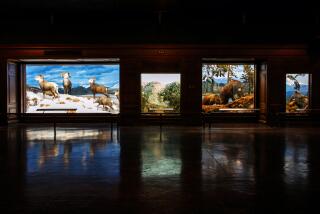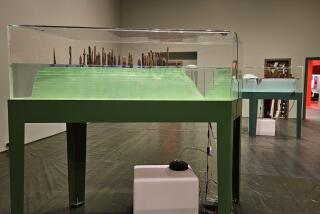Revealing a Vane Streak : Fullerton Museum Exhibition Also Has Array of Whirligigs Full of Social, Political Commentary
- Share via
As Bob Dylan once said, you don’t need a weatherman to know which way the wind blows. You don’t need a whirligig or a weather vane either, but, like Dylan, both of those instruments can also point the way to political statements or biting social commentary.
Take “Uncle Sam’s Shooting Gallery or Death Takes a Holiday,” a quirkily humorous take on the Gulf War. It’s one of 37 wind-powered objects making up the “Whirligigs and Weathervanes--Contemporary Sculpture” exhibition at Fullerton Museum.
There’s also “Dan Quayle Trips Over His Words” (words such as, “We are on an irreversible trend toward democracy--but that could change.”), and “Tactical Tuber,” which teeters a ‘tater ‘top a zucchini, both in the shape of rockets.
“I read [‘Tactical Tuber’] as a parody of the arms race . . . on the ludicrous side,” said Michael Whitenack, the show’s curator, in a phone interview from his office in Eugene, Ore. “Could tubers be tactical weapons?”
The answer, you might say, is blowin’ in the wind--as are, at least theoretically, most objects in the show. As for the difference between weather vanes and whirligigs, the former rotates as a single unit, the latter also has a propeller and/or other moving parts.
“A windmill is a giant version of a whirligig,” Whitenack noted. “The propeller turns a series of mechanisms that end up crushing grain, rather than making a few little figures dance.”
Weather vanes may have originated with the ancient Greeks; they were documented by Roman writers more than 2,000 years ago. The oldest one in the United States came from Holland in 1656 for installation on a church in Albany, N.Y., where it remains.
Whirligigs began as children’s toys; the earliest domestic examples, figures with spinning arms in Hessian uniforms, are thought to have been carved during the Revolutionary War by British-imported German troops.
Not all of the wind-powered items on display in Fullerton are intended for outdoor use. Joe McFall’s aforementioned “Uncle Sam’s Shooting Gallery” is one example.
For McFall, Whitenack said, “it’s the message rather than the medium. [The work] wouldn’t withstand being in strong wind for any period of time. . . . But that’s actually the way a lot of whirligigs were made in the old days. They might last for only one season, like a scarecrow.”
According to Dena Brown, director of Visual Arts Resources, the Eugene-based group touring the show, the pieces run a gamut both in durability and size. “They range from things that fell apart sitting on my desk,” she said, “to others that can last 200 years, like ‘Bufo.’ ”
“Bufo” is an eight-foot-tall weather vane, a frog fashioned from hammered plate copper on a base of zinc-coated steel. The artist is Keith Jellum of Sherwood, Ore., whose work also graces the library at the University of Oregon.
Among the whirligigs is a 26-inch crustacean--”Snapping Lobster (Cooked),” by Jane Corbus and Jeff Crew of Littleton, Mass.--with more than 100 moving pieces.
The show opened in Salem, Ore., in July, 1994, and finishes its run in the Rogue Gallery back in Oregon at the end of 1997.
“It may be extended, as long as the pieces are in good condition,” Brown said. “We had to design special crates for all of them that would be solid enough to survive three years on the road. The crating alone took three months. In them are hidden whirligig first-aid kits, with spare ball bearings and little pots of paint.
“Since each work separates into at least four or five pieces, we also had to produce a book and a video on how to unpack them and put them back together.”
Lynn Labate, the Fullerton Museum exhibition administrator, decided to run the two-hour video--as well as a music video by the group R.E.M. shot in the whirligig- and weather-vane-filled back yard of one of the artists--continuously during the show.
The nonprofit Visual Arts Resources organizes and tours exhibitions, most often to underserved rural and inner-city areas of the country. Nine shows will be traveling in 1996.
*
Brown considers this show the group’s most difficult to mount, and crating wasn’t the only reason.
“This isn’t historical folk art,” Brown said. “These are contemporary artists, and it took quite a long time to find these people. It took us six months just to get their names.
“When we invited them to submit their work, some had never taken a slide before. Probably only three had ever been in galleries. One artist in Tennessee I’ve still never spoken to, he’s so shy. I spoke with his friend in North Carolina, who used to be his neighbor.”
The artist was McFall; the friend, Howard Campbell, vice president of the North Carolina Folk Art Society, wrote “A Whirling Commentary” for the show catalogue, in which he reminisces about using weather vanes for target practice while growing up in Oklahoma.
He also quotes fellow North Carolina folklorist Roger Manley: While in the past whirligigs symbolized the interconnections of mankind and nature, says Manley, during the 16th Century “they became part of the iconography of madmen in paintings and woodcuts. The whirligig, which spun at the whims of the elements, was an apt image for the eccentric,” who was seen to be “at the mercy of outside forces and fates.”
Campbell himself takes a less scholarly turn, proposing that whirligigs are to other sculpture as limericks are to poetry. “And as with limericks, often the more shocking the better.”
* “Whirligigs and Weathervanes--Contemporary Sculpture” is on display at Fullerton Museum Center, 301 N. Pomona Ave., Fullerton, through Oct. 22. Open Friday through Sunday and Wednesday noon to 4 p.m. and Thursday noon to 8 p.m. Adults $2.50, seniors $2, students $1.50, under 12 free. All visitors free on Thursdays 6 to 8 p.m. (714) 738-6545.
More to Read
The biggest entertainment stories
Get our big stories about Hollywood, film, television, music, arts, culture and more right in your inbox as soon as they publish.
You may occasionally receive promotional content from the Los Angeles Times.










